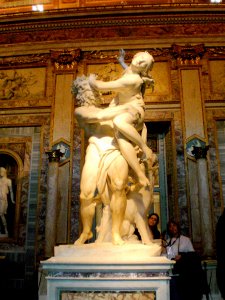Prosperina was playing in [a] glade
With her companions.
Brilliant as butterflies
They flitted hither and thither excitedly
Among lilies and violets. She was heaping
The fold of her dress with the flowers,
Hurrying to pick more, to gather most,
Piling more than any of her friends into baskets.
There the Lord of Hell suddenly saw her.
In the sweep of a single glance
He fell in love
And snatched her away -
Love pauses for nothing.
.
Terrified, she screamed for her mother,
And screamed to her friends. But louder
And again and again to her mother.
She ripped her frock from her throat downwards -
So all her cherished flowers scattered in a shower.
(The Rape of Proserpina from The Tales of Ovid tr. by Ted Hughes)
St Peter’s Basilica contains some of the most beautiful and awe-inspiring statues in Christendom - chief among them Michelangelo’s Pietà. However, when I visited the basilica a few years ago, it was another statue that really took my breath away. Actually, it wasn’t so much the statue as the decoration. Was it a cloud? A billowing cloak? Unfortunately, I can’t remember but the marble had been fashioned so realistically it really looked like someone was in the middle of airing the material. Even now, I am in awe of how someone was able to achieve such a dynamic and realistic effect.
.
The same feeling comes upon me each time that I look at the above detail from Gian Lorenzo Bernini’s Rape of Proserpina. I am sure that if Proserpina and Pluto were painted I would have trouble working out whether they were marble or models. It’s all so excitingly, poignantly, disturbingly lifelike.
.
The tale of Pluto’s abduction of Ceres’ daughter Proserpina is an account of how spring/summer turns to winter and back again. ‘Rape’ here is used in its older sense of meaning ‘to abduct’ (cf. The Rape of the Sabine Women). Ted Hughes’s poem is concise and unsparing but if I could change one thing about it I would remove the word ‘Hell’ as a descriptor of Pluto/Hades it gives the wrong impression of what kind of god he was.


